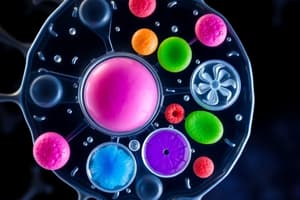Podcast
Questions and Answers
What is the primary role of adipose tissue?
What is the primary role of adipose tissue?
- Skeletal support
- Insulation and shock absorption (correct)
- Movement facilitation
- Oxygen transport
Which type of muscle is responsible for voluntary movement?
Which type of muscle is responsible for voluntary movement?
- Smooth muscle
- Cardiac muscle
- Skeletal muscle (correct)
- Involuntary muscle
What is the function of melanocytes in the skin?
What is the function of melanocytes in the skin?
- Produce keratin for strength
- Produce melanin for skin color (correct)
- Support sensory functions
- Generate energy stores
Which component of the nervous tissue is responsible for transmitting electrical impulses away from the nerve cell body?
Which component of the nervous tissue is responsible for transmitting electrical impulses away from the nerve cell body?
What is one characteristic of epithelial tissue?
What is one characteristic of epithelial tissue?
What is the primary function of the epidermis?
What is the primary function of the epidermis?
Which type of epithelial tissue is primarily responsible for the transport of oxygen to the blood?
Which type of epithelial tissue is primarily responsible for the transport of oxygen to the blood?
What function does stratified cuboidal epithelium serve?
What function does stratified cuboidal epithelium serve?
What type of connective tissue serves as a framework for the body?
What type of connective tissue serves as a framework for the body?
Which statement best describes smooth muscle?
Which statement best describes smooth muscle?
Which type of epithelial tissue has an impermeable barrier against bacteria?
Which type of epithelial tissue has an impermeable barrier against bacteria?
What is the primary role of blood as a connective tissue?
What is the primary role of blood as a connective tissue?
What is NOT a characteristic of muscles?
What is NOT a characteristic of muscles?
Which system is primarily responsible for taking in oxygen and expelling carbon dioxide?
Which system is primarily responsible for taking in oxygen and expelling carbon dioxide?
Which structure connects muscles to bones in the body?
Which structure connects muscles to bones in the body?
What type of connective tissue serves as filler in hollow organs?
What type of connective tissue serves as filler in hollow organs?
Which layer of skin is responsible for producing new skin cells?
Which layer of skin is responsible for producing new skin cells?
What type of cells make up bones and store calcium and phosphorus?
What type of cells make up bones and store calcium and phosphorus?
What is the smallest structure that can carry out the basic functions of life?
What is the smallest structure that can carry out the basic functions of life?
Which statement best defines prokaryotes?
Which statement best defines prokaryotes?
Who is credited with the discovery that all cells come from pre-existing cells?
Who is credited with the discovery that all cells come from pre-existing cells?
What is a zygote?
What is a zygote?
Which type of tissue covers the body surface and lines cavities?
Which type of tissue covers the body surface and lines cavities?
What did Francesco Redi contribute to the understanding of life origins?
What did Francesco Redi contribute to the understanding of life origins?
Which scientist is known for the discovery of bacteria?
Which scientist is known for the discovery of bacteria?
Which of these options correctly represents the levels of organization in living organisms?
Which of these options correctly represents the levels of organization in living organisms?
What is the main function of the digestive system?
What is the main function of the digestive system?
Which of the following components is part of the Central Nervous System (CNS)?
Which of the following components is part of the Central Nervous System (CNS)?
What role does the lymphatic system primarily serve?
What role does the lymphatic system primarily serve?
What does cellular respiration involve?
What does cellular respiration involve?
How does the excretory system maintain homeostasis?
How does the excretory system maintain homeostasis?
Which part of the nervous system is responsible for involuntary body functions?
Which part of the nervous system is responsible for involuntary body functions?
What type of balance does the excretory system primarily maintain?
What type of balance does the excretory system primarily maintain?
What are the two independent networks of the circulatory system?
What are the two independent networks of the circulatory system?
Flashcards are hidden until you start studying
Study Notes
Cell Theory
- Cells are the fundamental unit of life and smallest structure capable of performing life functions.
- Organisms consist of one or more cells and all cells originate from pre-existing cells.
- Key contributors to cell theory include:
- Hans and Zacharias Janssen - developed the first optical microscope.
- Anton Van Leeuwenhoek - discovered bacteria and coined the term “animalcules.”
- Robert Hooke - first to use the term “cell” after observing cork.
- Matthias Schleiden - all plants are made up of cells.
- Theodore Schwann - concluded that all animals are composed of cells.
- Rudolf Virchow - asserted that "Omnis cellula e cellula," meaning all cells arise from pre-existing cells.
Zygote
- Defined as a fertilized egg formed by the union of an egg cell and a sperm cell.
Levels of Organization
- Biological organization follows a hierarchy: Cells > Tissues > Organs > Organ Systems > Organisms.
Cell Classification
- Living organisms are classified based on the presence of a nucleus:
- Prokaryotes - lack a defined nucleus (bacteria).
- Eukaryotes - have a defined nucleus (plants, animals).
Cell Structures
- Organelles are specialized internal structures within cells, observable under an electron microscope.
Human Tissue Types
- Four main types: Connective Tissue, Epithelial Tissue, Nervous Tissue, Muscle Tissue.
Epithelial Tissue
- Serves as a protective layer covering body surfaces and lining cavities.
- Functions include lining, protection, and forming glands (e.g., saliva, sweat).
- Types of epithelial tissue are classified by cell layers and shapes:
- Simple (one layer) vs. Stratified (multiple layers).
- Squamous (tile-like), Cuboidal (cube-like), Columnar (rectangular).
Connective Tissue
- Connects and supports various body parts; types include:
- Bones - provide structure and support.
- Blood - fluid connective tissue crucial for transport of oxygen and cells.
- Dense Connective Tissue - includes ligaments (bone to bone) and tendons (muscle to bone).
- Adipose Tissue - serves as insulation and shock absorber.
Muscular Tissue
- Composed of muscle cells that facilitate movement.
- Types of muscle tissue:
- Skeletal Muscle - voluntary movement, attached to the skeleton.
- Smooth Muscle - involuntary, controls internal functions (e.g., digestion).
- Cardiac Muscle - involuntary, responsible for heart contractions.
Nervous Tissue
- Comprises neurons that transmit electrical impulses, connecting the brain and spinal cord to the body.
- Key components include:
- Neurons - transmit signals.
- Axons - carry impulses away from the cell body.
- Dendrites - receive impulses toward the cell body.
Human Organ Systems
- Integumentary System: Protects body, regulates temperature, comprises skin, hair, nails.
- Muscular System: Facilitates movement and physical support.
- Skeletal System: Provides structure, protects organs, produces blood cells.
- Respiratory System: Manages gas exchange (oxygen in, carbon dioxide out).
- Digestive System: Breaks down food, absorbs nutrients, and eliminates waste.
- Excretory System: Maintains osmotic balance and eliminates metabolic waste.
- Nervous System: Controls body functions using the brain, spinal cord, and nerves.
- Endocrine System: Regulates bodily functions through hormones.
- Lymphatic System: Transports lymph and helps eliminate waste.
- Circulatory System: Composed of the pulmonary and systemic systems to manage blood flow.
Skin Structure
- Comprises three layers:
- Epidermis: Outer layer, protective, produced by keratinocytes.
- Dermis: Middle layer, contains connective tissue, sensory structures, and sweat glands.
- Hypodermis: Inner layer, stores energy and connects skin to muscles.
Key Functions of Skin Cells
- Keratinocytes: Produce keratin.
- Melanocytes: Generate melanin, protecting against UV radiation.
- Langerhans: Play a protective role against pathogens.
Studying That Suits You
Use AI to generate personalized quizzes and flashcards to suit your learning preferences.




